Making gluten free artisan bread is not only possible, it’s downright easy! You don’t even need a bread pan — just a baking sheet and parchment, plus the right ingredients, of course — and you’ll be baking crusty bread like a true artisan!
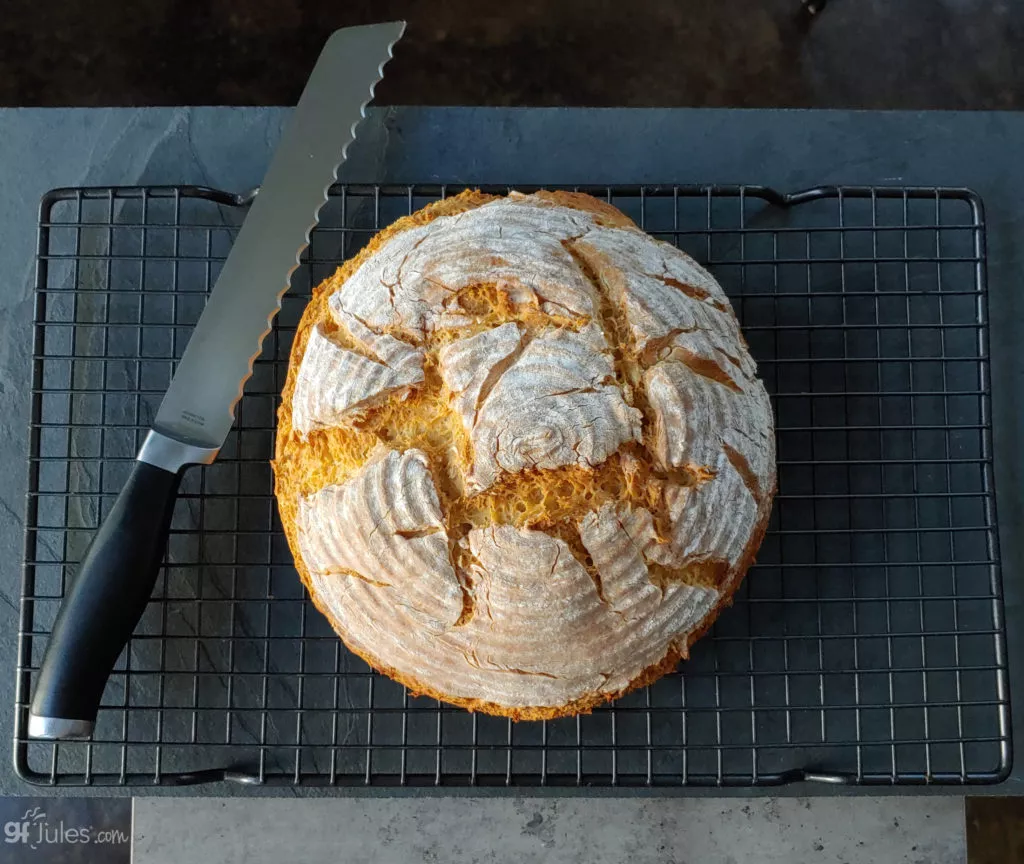
You don’t want to use heavy, gritty gluten free flours if you want your loaf to be light and airy like this one, so follow along and you’ll be serving beautiful, impressive, crusty gluten free artisan breads in no time!
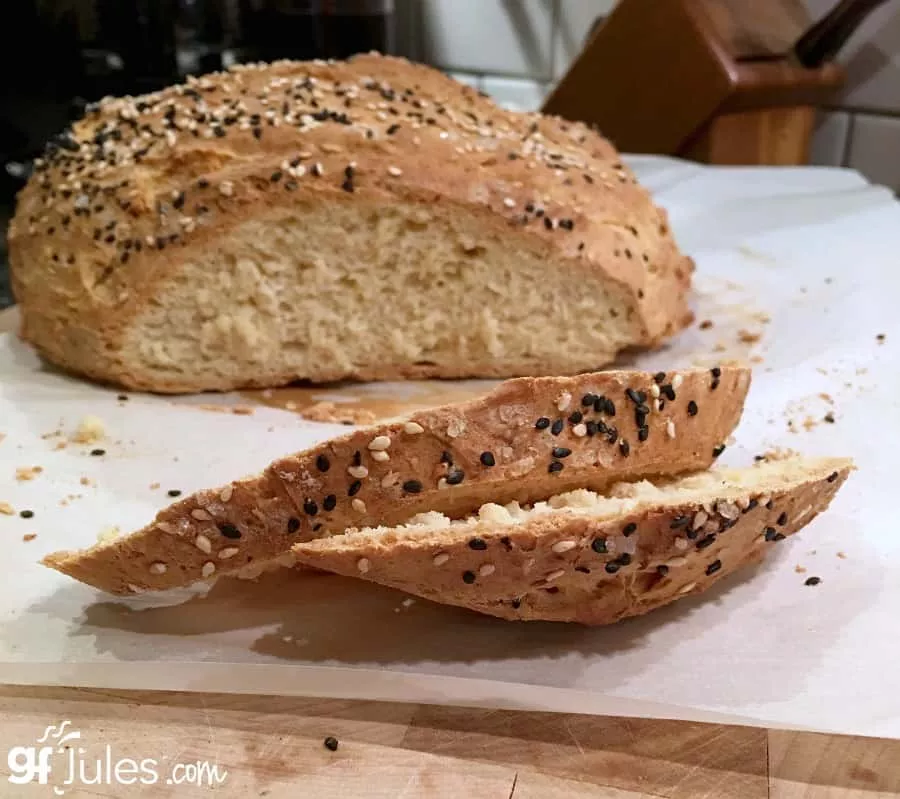
You know me — I’m always here for you with options! This recipe is no exception.
I give two options, use my award-winning super easy gfJules Bread Mix or my from-scratch recipe. And within that from-scratch recipe, there are two major options for baking without a pan for a true gluten free artisan bread look or partially baking in a round or springform pan for a more rounded loaf that even works well as a bread boule for soup!
Which will you choose?
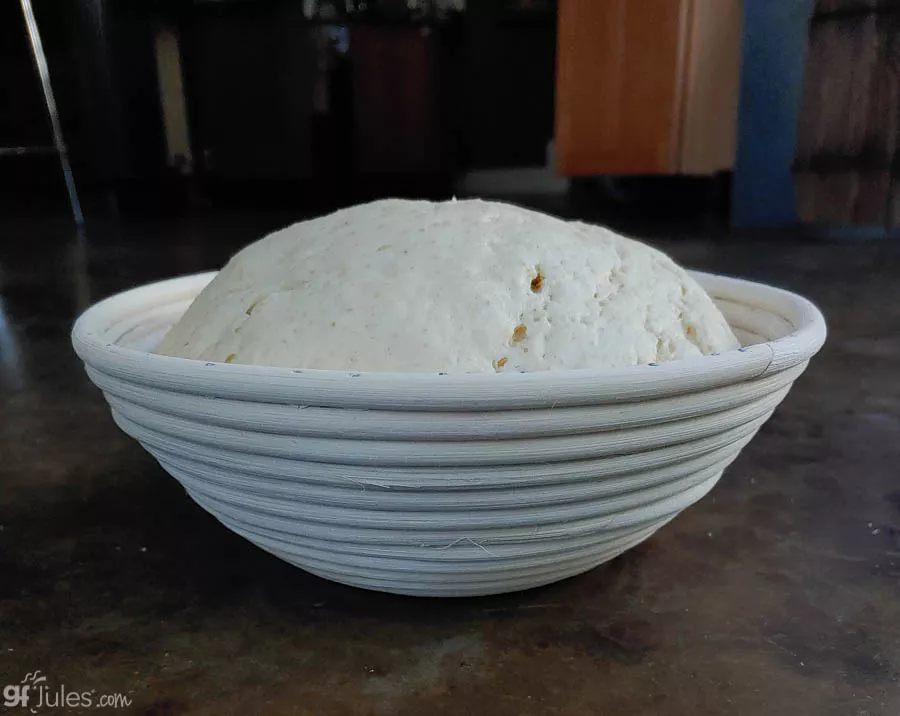
Especially if using bubbly water or gingerale or even gluten free beer(!) as the liquid in this recipe, your dough will need some help holding together until mid-bake (*unless using my gfJules Gluten Free Bread Mix — see recipe cards).
I prefer yogurt (I use vegan yogurt) for this recipe if baking from scratch and without a pan for the best, roundest shape, and using a bowl or proofing basket is always a handy way to help it rise in a rounder shape. How beautiful is this risen bread in a banneton?
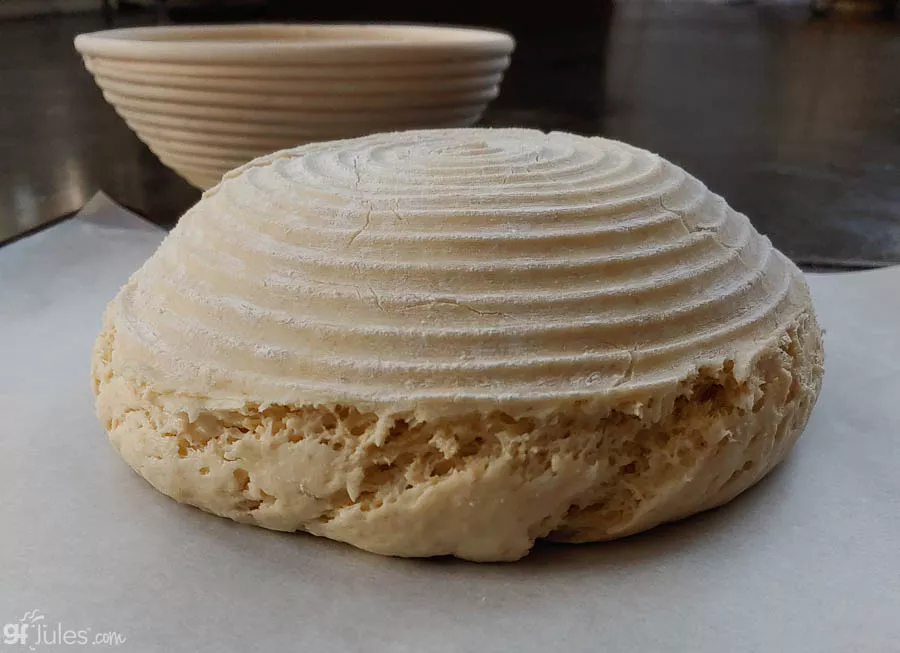
Use a proofing basket like this one, a parchment-lined springform pan, or even a glass (oven-safe) bowl lined with oiled parchment, the dough can rest for as little as 30 minutes to overnight (covered) in the refrigerator while rising in the style of sourdough, if you like.
If using a thinner liquid in the recipe — like sparkling water or club soda — you may choose to leave it in the pan or bowl (not the basket) for half the bake time, then gently pull up on the parchment to remove it from the pan and place it (with parchment) onto a baking sheet and return to the oven.
If using yogurt and a proofing basket, remove it before baking and it will keep a lovely round shape but not rise quite as high.
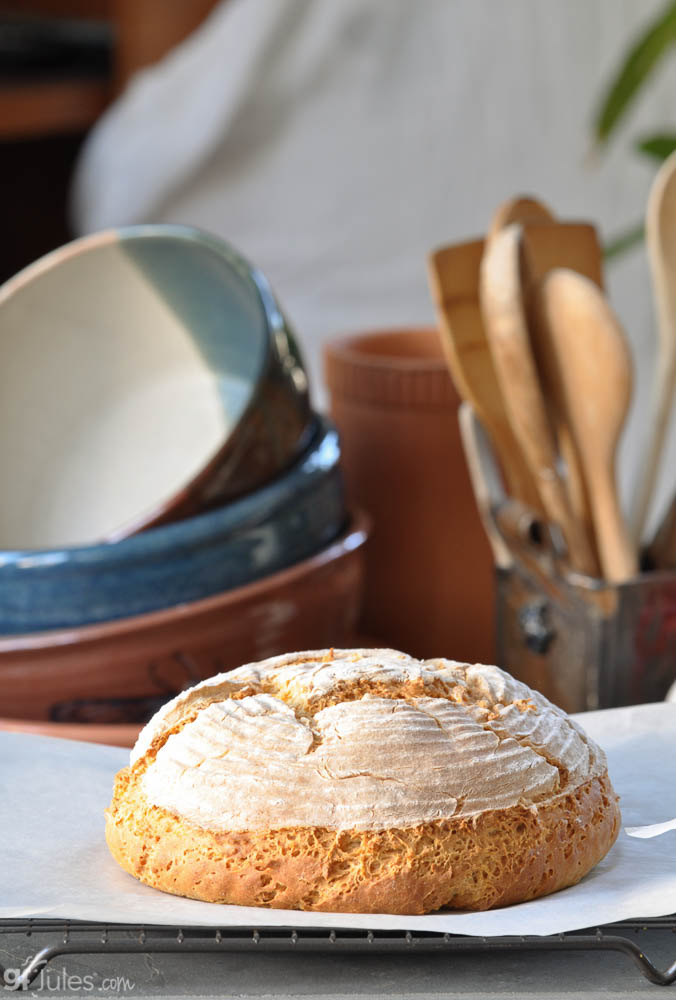
Every time you bake this gluten free artisan bread, it will take its own shape. It’s part of the beauty of this bread. No two breads will ever look alike, nor should they. Like snowflakes, they’re each unique and beautiful.
Here’s a picture of one reader’s lovely loaf. See, you can do it, too!

I can’t stop taking pictures of these loaves because every time they’re show-stoppers.
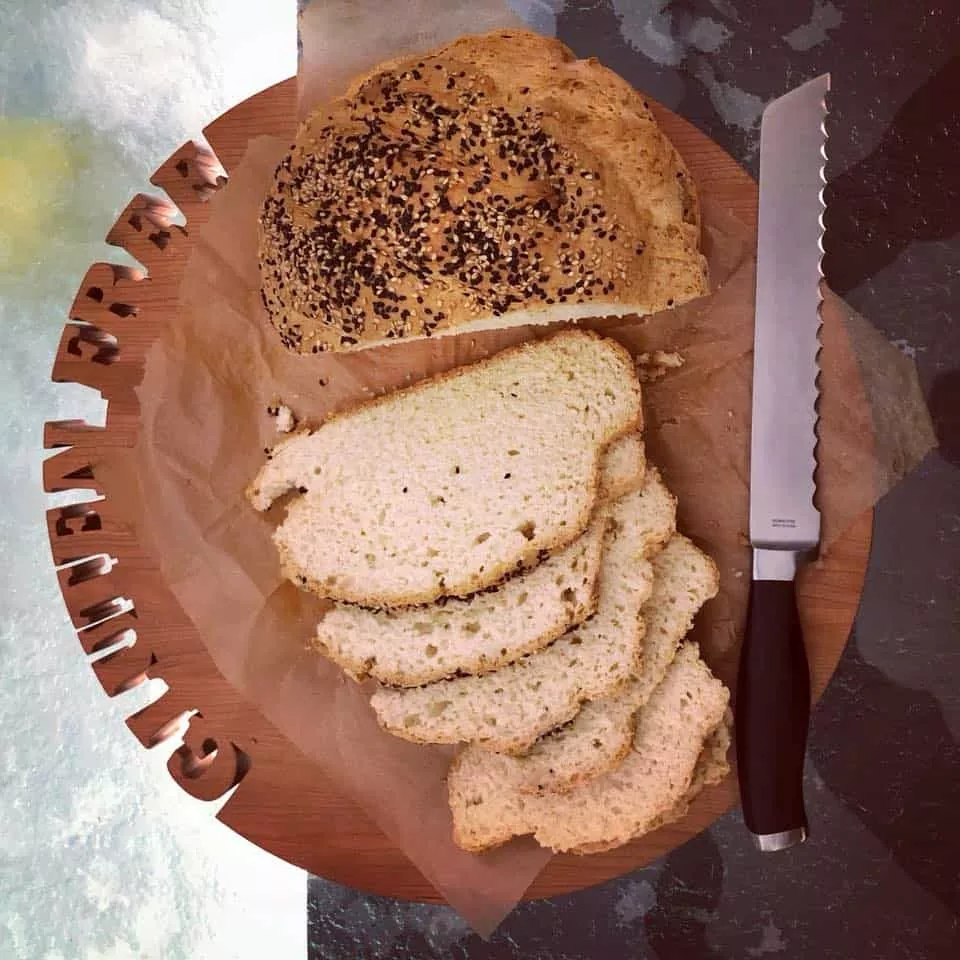
Check out the video below to watch me make gluten free artisan bread in a springform pan in case you don’t have any of these other options … so you know just how easy it is!
NOTE: my gfJules Gluten Free Bread Mix is now UPDATED and stays soft and fresh even longer! It also doesn’t require a springform pan for rising in this recipe, although I love the look of it after rising in a banneton proofing basket!

Here’s a look at it sliced. This bread, as baked is vegan (egg-free), but feel free to add an egg or two if you prefer a more open cell structure.

Gluten Free Artisan Bread Recipe made with gfJules Bread Mix

Gluten Free Artisan Bread Recipe made with gfJules Bread Mix
Equipment
Ingredients
PLUS
- 2 1/4 tsp quick rise yeast 1 packet like Red Star
- 4 1/2 Tbs. sugar 56 grams or sugar sub OR 3 Tbs. honey or agave or maple syrup
- 1 3/4 cups warm water OR bubbly liquid like GF beer or ginger ale or 1 1/2 cups water + 1 large egg
Instructions
- In the large mixing bowl of a stand mixer or just a mixing bowl, stir together the liquids with gfJules Gluten Free Bread Mix, yeast, and sugar by pouring slowly into the bowl while mixing with the paddle attachment. Beat well – 2-3 minutes.
- Dust a pastry mat or clean counter with more gfJules Flour and transfer the dough onto the surface, rolling gently in the flour to cover all sides. Knead to form a smooth ball.
- Transfer to a proofing basket (as pictured), bowl or oiled parchment-lined glass bowl.
- Cover loosely with a warm, damp tea towel or piece of oiled parchment paper and place in a warm spot to rise for 30 minutes - 1 hour.
- Preheat oven to 475º F (static) or 450º F (convection).
- Gently transfer to a parchment-lined baking sheet (flip so that the bottom of the proofing basket is the top of the bread). Remove proofing basket or bowl and dust with more gfJules Flour.
- Wet a large serrated knife or use dough lame and cut into the bread across the top or use the lame to cut into the bread in a decorative pattern. This will give the bread natural rifts to rise from, and make it even prettier once baked.
- Bake for 30-35 minutes on the lower rack, testing with an instant read thermometer to ensure it's fully baked before removing from the oven. The thermometer should have reached 205º F. If the top of the bread is getting too dark, cover with foil.
- Remove to cool on a wire rack (at least 20 min) before slicing or the bread may get rubbery when pushed down upon while slicing.
** Please keep in mind that nutrition information provided is per serving, which may vary. While we have taken care to provide you with the most accurate nutritional values possible, please note that this information may differ significantly depending on the exact ingredients and brands that you choose to use to make this recipe. Additionally, where options are given for ingredients, the resulting calculation may include all ingredient options instead of only one per line, skewing the totals significantly.
Recommended Products
Any links to Amazon may earn me a small amount from qualifying affiliate purchases; this amount goes to fund this blog and does not cost you anything additional.
Gluten Free Artisan Bread Recipe from Scratch with gfJules Flour
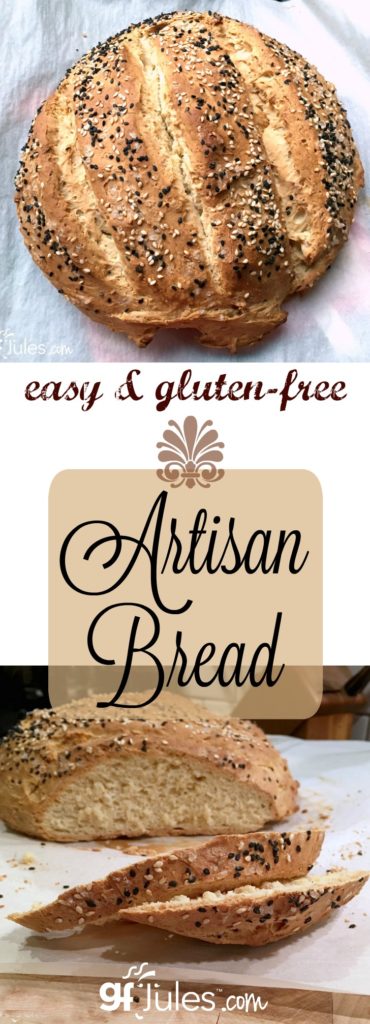

Gluten Free Artisan Bread Recipe
Equipment
Ingredients
- 3 cups 405 grams gfJules® Gluten Free All Purpose Flour
- 1/4 cup flax seed meal or gfJules Gluten Free Multigrain Baking Flour
- 1/4 cup dry milk powder dairy or non-dairy (e.g. Coconut Milk Powder) - preferred - OR almond meal (in a pinch)
- 1/2 tsp. baking soda
- 2 tsp. baking powder
- 1 tsp. sea salt
- 1 tsp. apple cider vinegar
PLUS:
- 2 Tbs. honey agave nectar or coconut palm nectar
- 1 1/4 cup room temperature liquid: EITHER plain yogurt* OR milk not skim OR sparkling water OR ginger ale OR gluten free beer (bubbly liquids make the bread rise higher and lighter but will need support from a bowl to rise and partially bake - see intro before recipe card)
- 1/4 cup extra virgin olive oil
- 2 large eggs OR 2 Tbs. flax seed meal steeped for 10 minutes in 6 Tbs. hot water
- 2 1/4 tsp. one packet rapid rise or bread machine yeast, gluten-free (Red Star Quick Rise®)
toppings (optional):
- flaxseeds or sesame seeds
- coarse sea salt
- egg mixed with 1 Tbs. water to brush onto crust for darker color optional
- oil to brush on top
Instructions
- Whisk these dry ingredients together in a large bowl: flours, milk powder, baking soda, baking powder and salt. Set aside.
- In the large mixing bowl of a stand mixer or just a mixing bowl, stir together the wet ingredients (honey, yogurt, apple cider vinegar, oil, and egg or flax seed and water mixture). Gradually add the dry ingredients in with the wet by pouring slowly into the wet bowl while mixing with the paddle attachment. Once incorporated, add the yeast granules, and beat well – 2-3 more minutes.
If baking with yogurt:
- The dough will be very thick (much more like regular wheat flour bread dough than you may be used to with gluten free); however, if the dough seems too thick or dry, gradually mix in milk, one tablespoon at a time, until the dough is still thick, but able to be smoothed with a spatula.
- Liberally dust a pastry mat or clean counter with more gfJules Flour and transfer the dough onto the surface, rolling gently in the flour to cover all sides. Knead slightly, if necessary, to form a smoother ball.
- Transfer to a proofing basket, bowl or oiled parchment-lined glass bowl.
- Cover loosely with a piece of oiled parchment paper and place in a warm spot to rise for 30 minutes - 1 hour.
- Preheat oven to 350º F (static) or 325º F (convection).
- Gently transfer to a parchment-lined baking sheet.
- Brush with egg wash or oil, then lightly dust the top with more gfJules Flour.
- Wet a large serrated knife and press into the bread in 2 or 3 lines 1/2 inch deep, rocking the knife back and forth to open the cuts slightly wider or use a lame to cut into the bread in a decorative pattern. This will give the bread natural rifts to rise from, and make it even prettier once baked.
- Spritz with water once risen, if you prefer an even crunchier crust.
- Place an oven-safe bowl or pan on the bottom shelf of your oven and fill with ice cubes. The steam from melting ice cubes will help your bread get even crustier!
- Bake for 30-40 minutes, testing with an instant read thermometer to ensure it's fully baked before removing from the oven. The thermometer should have reached 200º F.
- Remove to fully cool on a wire rack.
If baking with another liquid:
- The dough will be more batter-like, so it still needs some support while rising and baking. Choose an oven-safe deep, round pan or bowl, pyrex, or even a springform pan. Line with oiled parchment and transfer the dough to the pan, smoothing the top with a wet spatula and mounding it more in the middle of the pan rather than flattening it out.
- Cover loosely with a piece of oiled parchment paper and place in a warm spot to rise for 30 minutes - 1 hour.
- Brush with egg wash or oil, then lightly dust the top with more gfJules Flour.
- Wet a large serrated knife and press into the bread in 2 or 3 lines 1/2 inch deep, rocking the knife back and forth to open the cuts slightly wider or use a lame to cut into the bread in a decorative pattern. This will give the bread natural rifts to rise from, and make it even prettier once baked.
- Spritz with water once risen, if you prefer an even crunchier crust.
- Preheat oven to 350º F (static) or 325º F (convection).
- Place an oven-safe bowl or pan on the bottom shelf of your oven and fill with ice cubes. The steam from melting ice cubes will help your bread get even crustier!
- Bake for approximately 15 minutes, then lift up on parchment and remove the bread from the pan. Lay parchment with bread on top of a flat baking sheet. Otherwise, leave dough inside the pan for support.
- Bake for 20-25 more minutes, testing with an instant read thermometer to ensure it's fully baked before removing from the oven
- Depending on the size of the pan used, and therefore the height of the loaf, it may need to cook longer to be fully done. The thermometer should have reached at least 200º F.
- Remove to full cool on a wire rack for 10 minutes.
Video
Notes
** Please keep in mind that nutrition information provided is per serving, which may vary. While we have taken care to provide you with the most accurate nutritional values possible, please note that this information may differ significantly depending on the exact ingredients and brands that you choose to use to make this recipe. Additionally, where options are given for ingredients, the resulting calculation may include all ingredient options instead of only one per line, skewing the totals significantly.
Recommended Products
Any links to Amazon may earn me a small amount from qualifying affiliate purchases; this amount goes to fund this blog and does not cost you anything additional.
Pin for later!
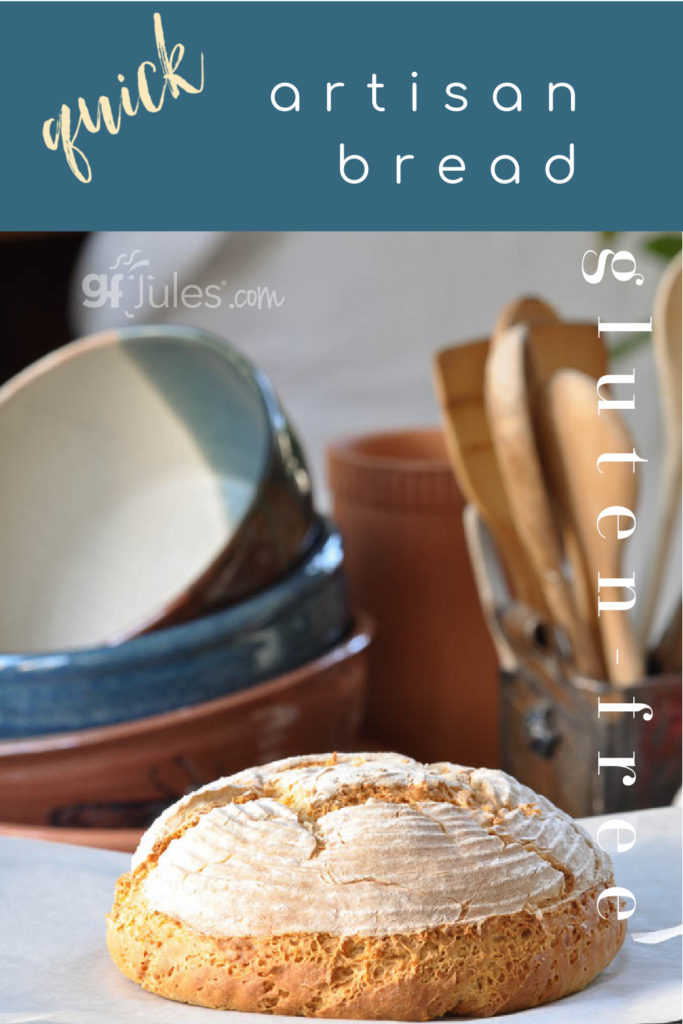
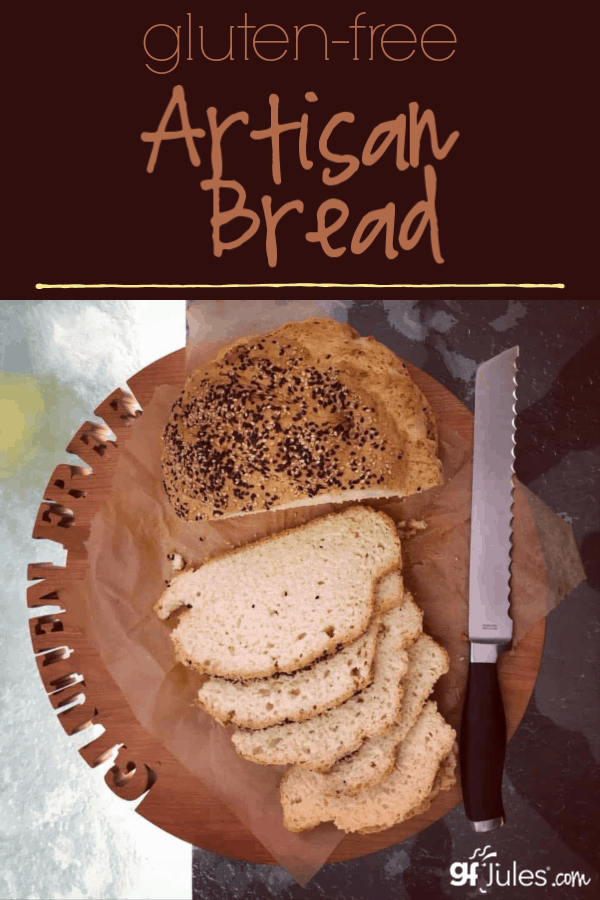

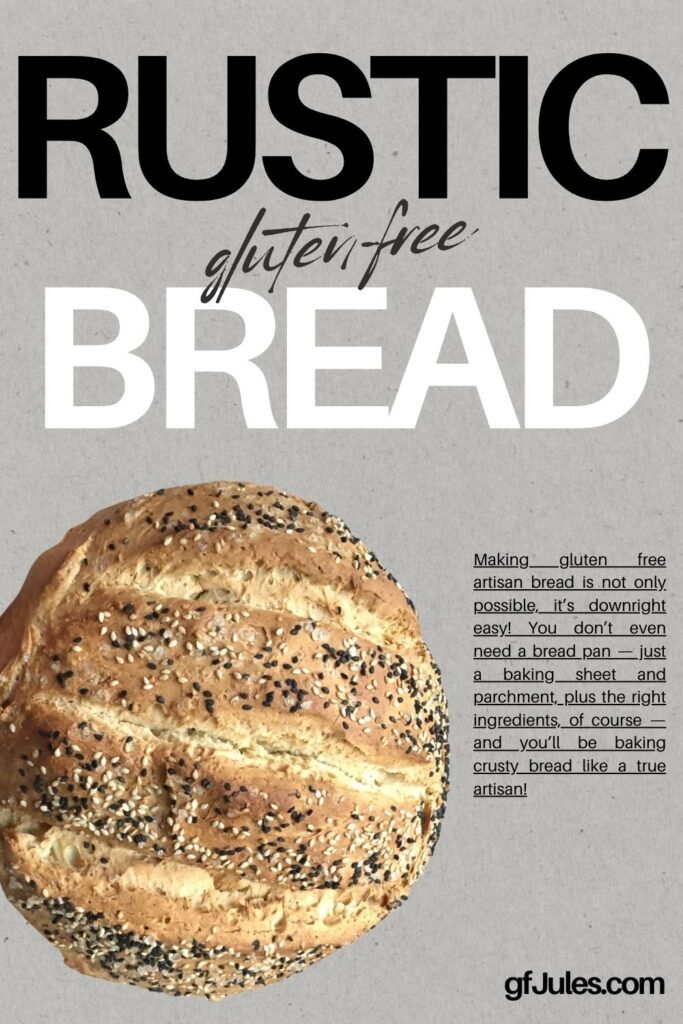
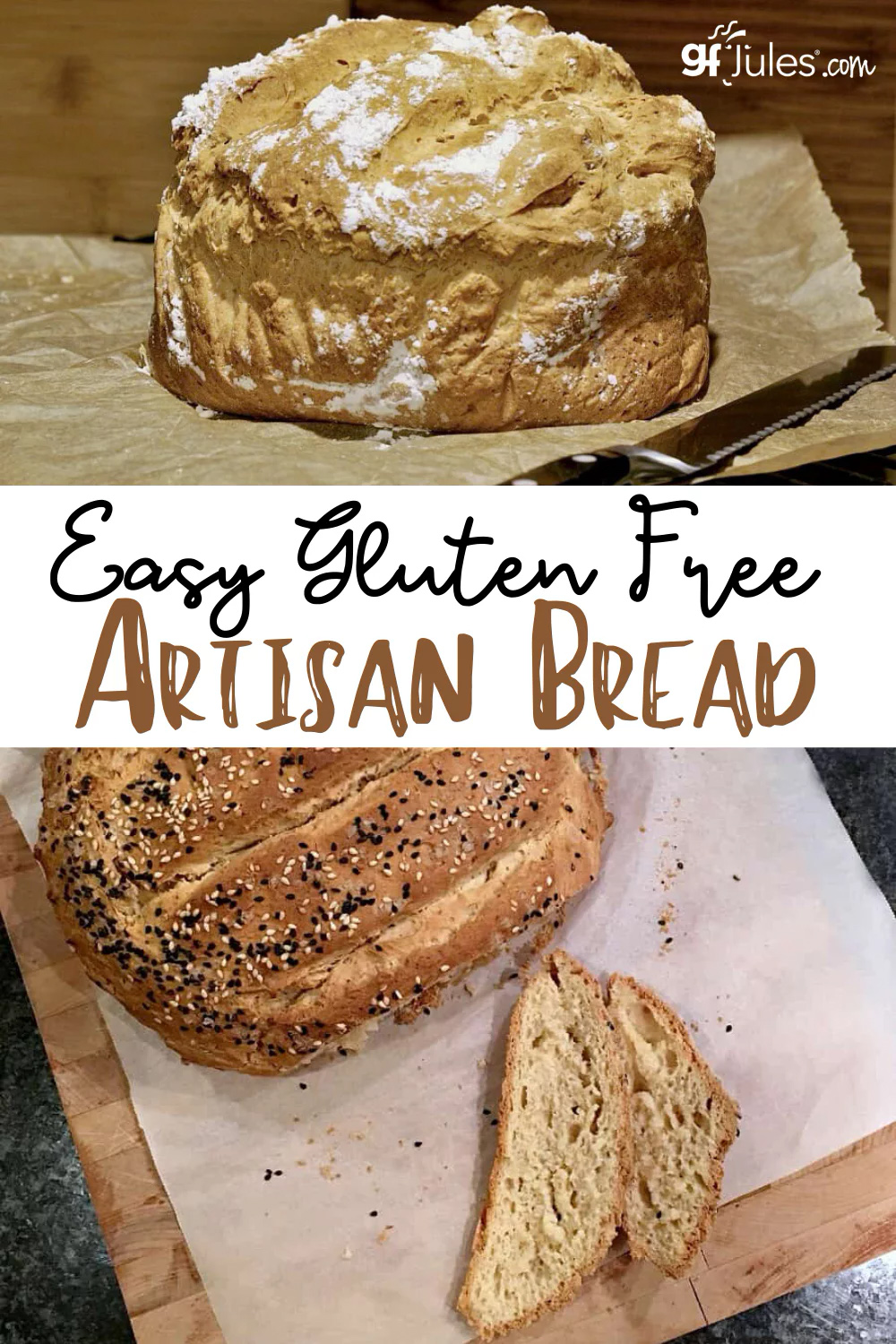
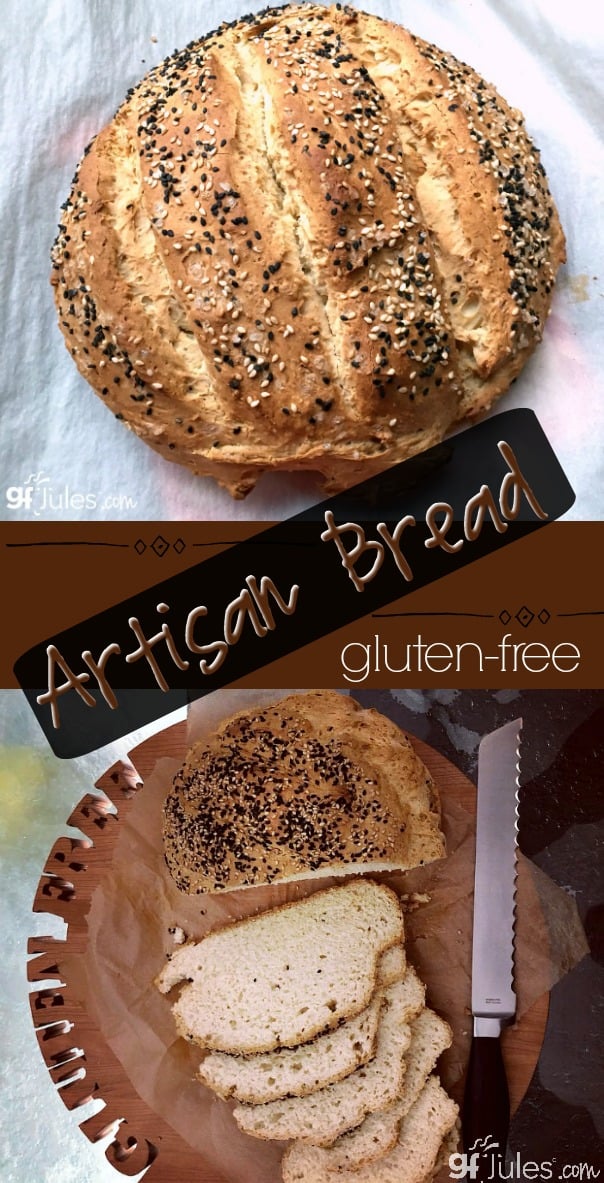
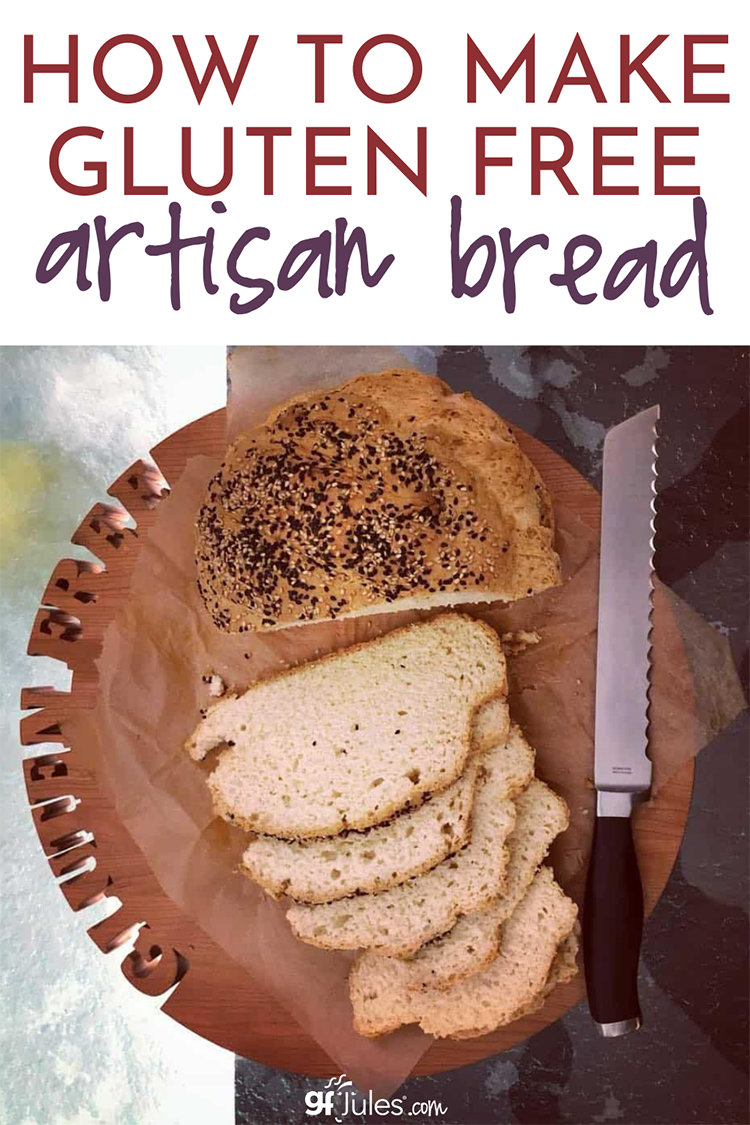
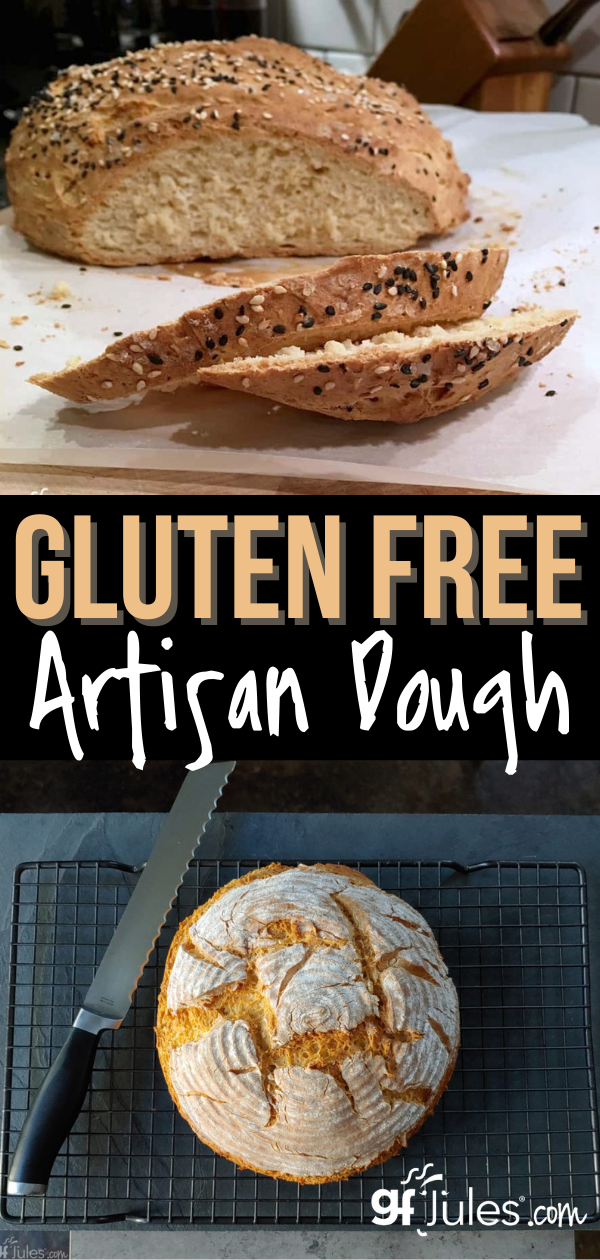
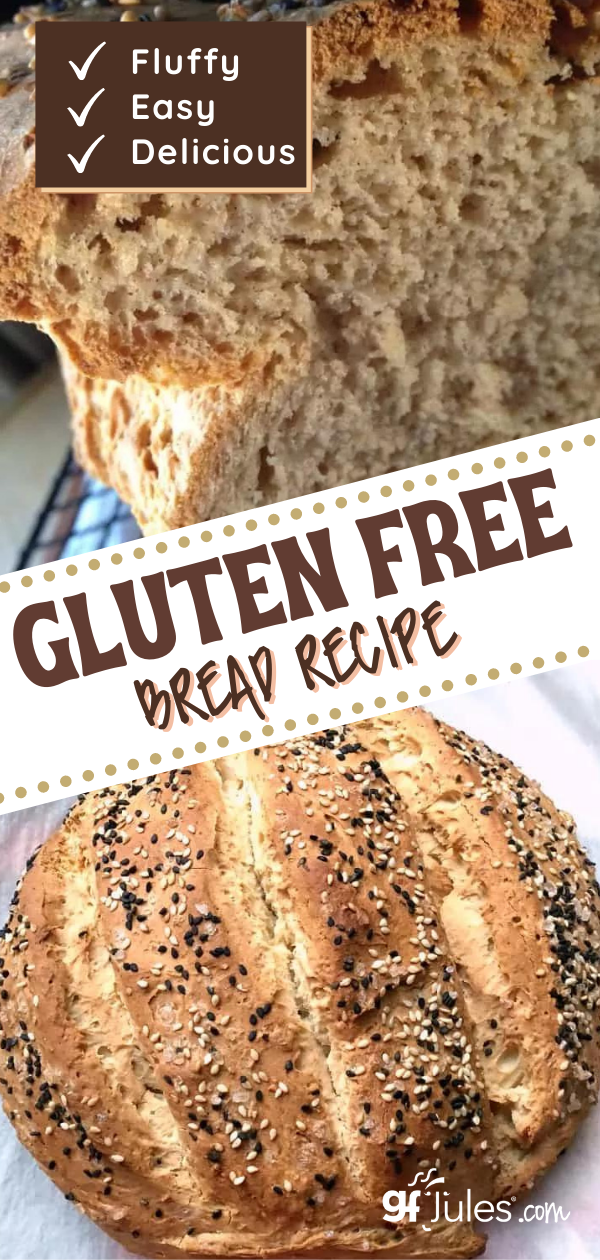
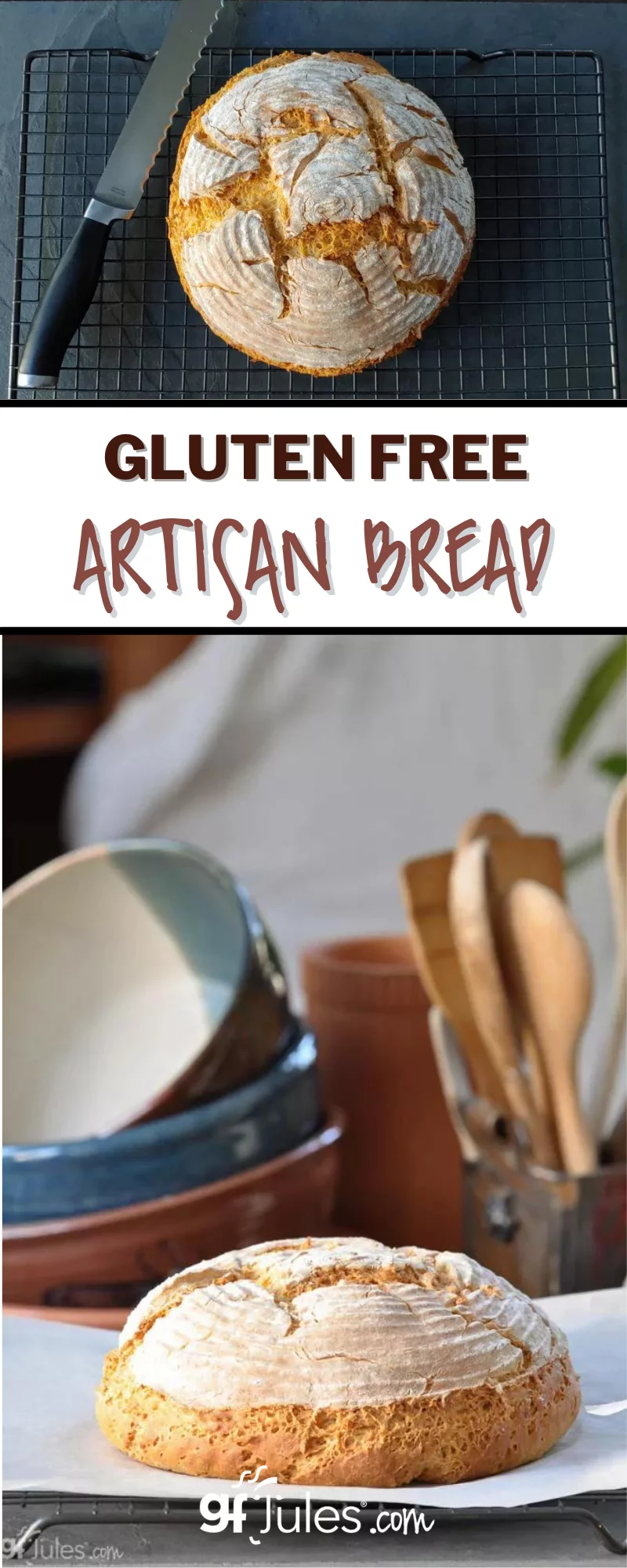
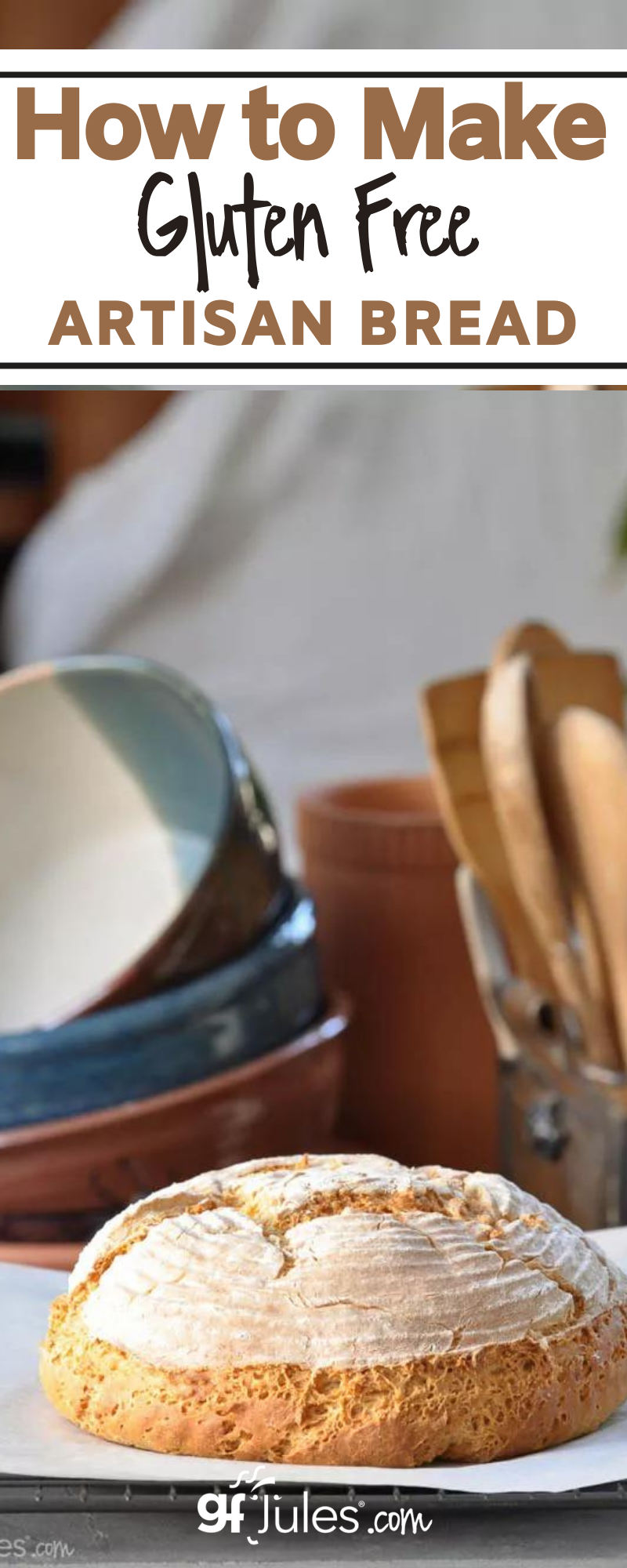


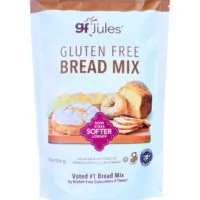
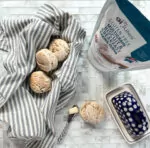
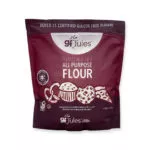
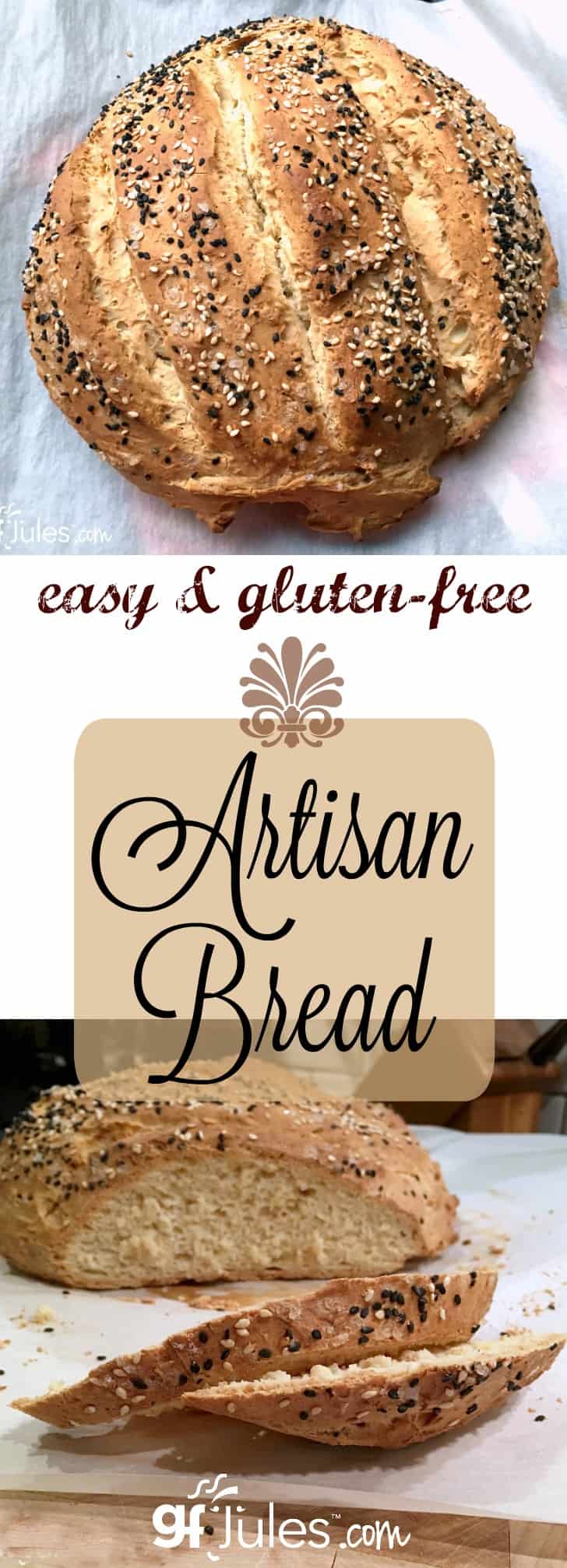











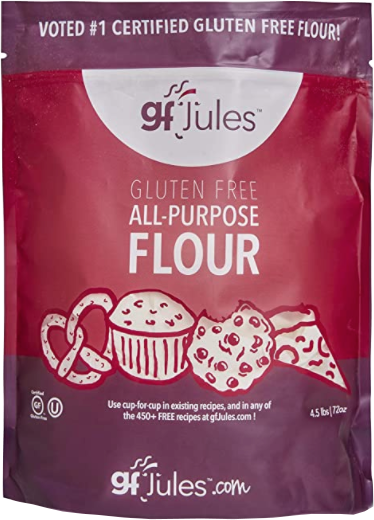
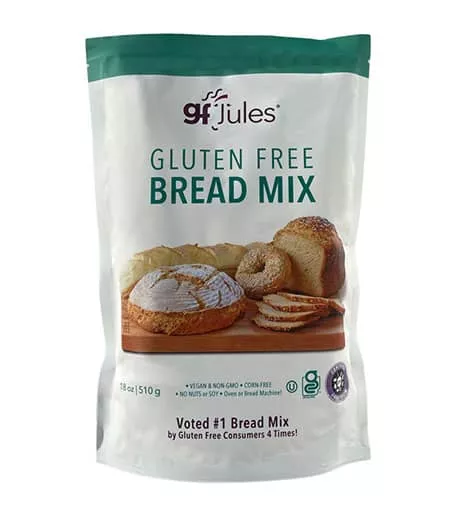

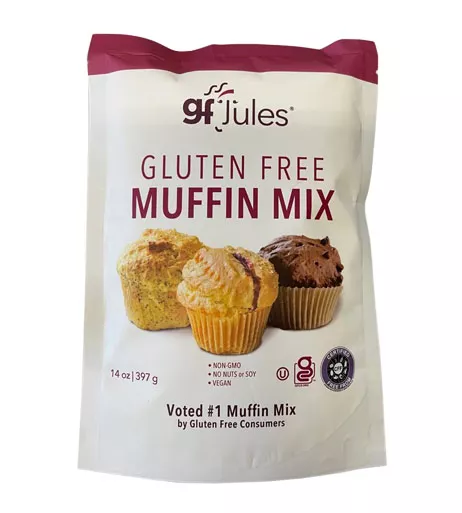


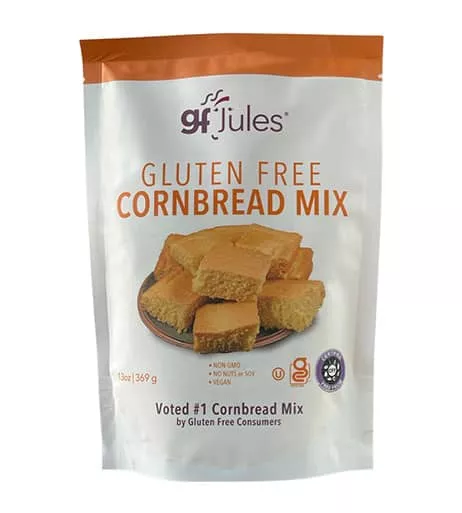



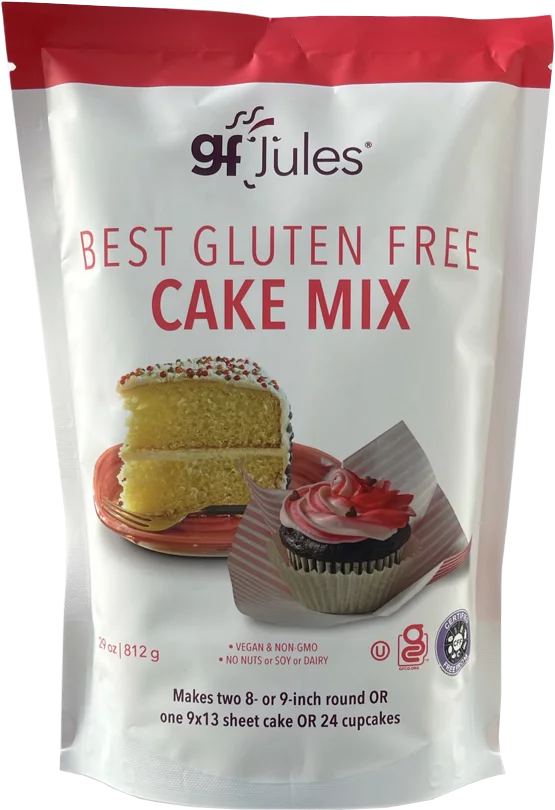
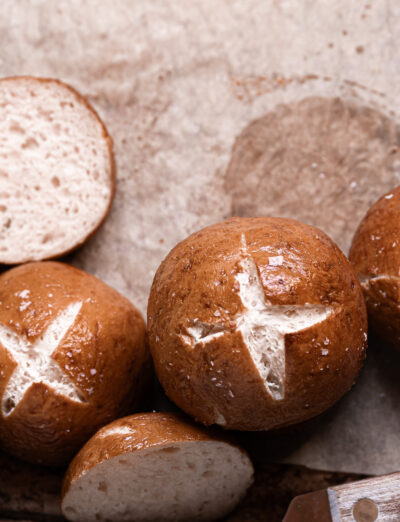


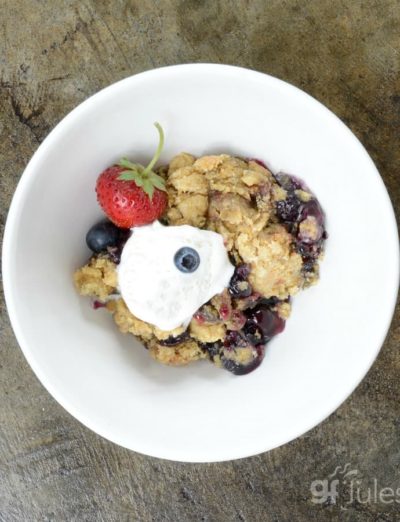







Sadly, my loaf was a disaster. The thermometer read only 120 degrees after the suggested baking time of 20-25 minutes, so I left it in the oven to bake for about 35 minutes total, but it still never reached 200 degrees internally. The loaf came out with a burnt flavor, dark color, and hard texture. Completely inedible. It was a waste of expensive GF Jules flour and all of the other ingredients. I followed the rest of the recipe to a T, used milk, honey, and eggs.
Hi Tara, I’m sorry to hear that your artisan bread didn’t turn out. There are always variables when baking bread from scratch, so let’s look at a few and see if we can figure out what might have happened. Did the bread rise but just not seem to fully cook until it was burned? Did you leave it to bake until the internal temp reached 200F but it was burned, dark and hard? Do you happen to have an oven thermometer, or know if your oven is baking true to temp? Have you read this article on gluten free bread baking? Check your method and ingredients, etc against the tips here to see if I’ve missed anything or if you may have done something differently that we just haven’t covered: https://gfjules.com/18-tips-for-gluten-free-bread-baking/
You can also call us (410-744-1845) and we can talk further about the recipe and see what we can figure out might have gone wrong, but it really sounds like an over-baking situation and that your oven might have something to do with it. All ovens bake a bit differently and most people are surprised to learn that their oven isn’t calibrated correctly. If your oven bakes unevenly or hot then cold, it can really have an effect on recipes like this, drying them out and changing the bake times, particularly when a pan isn’t used, as there’s nothing to help hold the moisture into the bread while it’s baking. I hope that helps!
~jules
Hi Jules,
This recipe is wonderful – thank you so much for developing and sharing it. Not only is it my new favorite gf bread, but it‘s also the easiest of all of the artisan bread recipes I’ve tried.
I went with the yogurt version (and I actually realized as I was making it that I only had active dry yeast. I bloomed it in warm water and added a bit of extra flour to account for the liquid, and it worked out perfectly). I was a bit nervous when the dough didn’t rise much during the proof, but I kept going, and when I checked on it 15 minutes into the bake, it had risen all the way past the top of my mini Dutch oven.
I topped it with a seed and seasoning mix, and enjoyed it with a Moroccan lentil stew.
I’ve always considered bread to be the sort of labor of love I can only make on my days off from work, but this bread is easy enough that I can start it when I get home and have it ready by 7. I can’t wait to make this bread again!
The benefits of baking gluten free, right?? It’s amazing how wonderful homemade gluten free bread can be, when it takes so little time to make it!! So glad you enjoyed this gluten free artisan bread recipe so much. It certainly looks perfectly hearty with that lovely bowl of stew. The perfect accompaniment!
Thanks for taking the time to share your photo and also the modifications you made with the active dry yeast, dutch oven, and yogurt. I’m sure it’ll help other readers if they are using any of the same things.
Happy baking, Taylor!
~jules
Is it ok to replace cream cheese for the yogurt? Thanks
Hi John, I don’t think it will work out here as cream cheese is so much thicker and has less moisture than the American style yogurt contemplated. You could go half and half with cream cheese and milk though, to balance out the moisture.
~jules
Hi Jules,
Made your bread this morning. I proofed mine in the oven like you said in your video, but it didn’t seem to rise much. Should I expect this loaf to double like regular bread? Also, I had to cook mine way longer than the suggested 30-40 minutes, closer to an hour before the thermometer read 200*. Should I have raised my oven temp even though I used convection?
All in all, bread smells yummy and looking forward to trying it!
Thanks
Hi Holly, thanks for the questions — happy to help!
Don’t expect gluten free bread doughs to typically double in size during the rise. If it rose but didn’t double, and still smelled yeasty, it’s probably on the right track!
Regarding baking longer, that’s ok; the important part is that it was cooked through, so I’m glad you were able to take its temp! All ovens bake a bit differently and even different rack placement can change things. Can’t wait to hear how it turned out when you sliced it!!
~jules
Can I make this without the honey? Or is there something to replace the honey I can use?
Hi Erin, yes! You can use another liquid sweetener like maple syrup, agave, coconut nectar, date syrup or the like. Hope that helps!
~jules
I was on a GF diet for awhile to see if that was the cause for some medical issues. It was not. During that time I made your Artisan Bread and we loved it every time. Now I want that bread but no longer have the GF flour. How can I make this with a non GF flour? Will I still need the Flax flour?
Thanks and keep inspiring people to bake with no fear.
Hi Janice, you should be able to total the amount of flours called for in this recipe and just use all purpose wheat flour instead. I hope you’re feeling lots better!!! Thanks for the kind words!
~jules
Hi there! I’m trying your flour for the first time today (very excited!). The flavor of the loaf is good, but I definitely messed something up because it didn’t rise. I used almond meal and sparkling water. All the ingredients I used are fresh. The batter seemed thicker than gluten free bread dough usually looks, although nowhere near what glutinous dough looks like. Not sure if that has anything to do with it. Any idea where it could have gone wrong?
Thanks!!
Hi Lorell, glad the flavor is good, but we definitely need to get that bread to rise! The fact that you used sparkling water as the liquid, but described the dough as being very thick seems off to me, as this dough — when sparkling water is used — should have reminded you much more of a typical gluten free bread dough, in that it is more batter-like. When yogurt is used instead, the dough is manageable like a “dough” and can be handled a bit more like wheat flour bread doughs.
Since you’re new to baking with my flour, I always like to make sure people are familiar with the best methods for measuring gluten free flours, in case that might have had something to do with why this dough was too tight and didn’t rise. Have a look at this article on how to measure gluten free flours so you know for all recipes going forward.
Other than that, do you recall if the dough smelled “yeasty” when it had risen? I’m assuming you used quick rise yeast and so you didn’t proof it; the only real way to tell with quick rise whether it’s active is to see if it smells like yeast before you bake it, and of course, to see if there’s any rise after the proofing period (which apparently there wasn’t).
Those would be my first two guesses here, but take a look at this article on baking gluten free bread and see if any of these other tips resonates with any of your method or other things you noted in the bread results.
Hopefully one of these ideas helps for next time!!! I’d also recommend milk powder with this recipe instead of almond meal if you can find it — it definitely does produce better results, but I don’t think that was the whole issue here.
Let me know how it goes next time!!
~jules
Hi Jules,
Thank you so much for taking the time to make such a prompt and thorough response. The article you linked was incredibly helpful. My kitchen definitely wasn’t warm enough, so proofing was taking way longer than I was expecting it to. I haven’t gotten a chance to remake this loaf (it’s on my to do list), but I made your pull-apart dinner rolls today and they are absolutely FANTASTIC. I can’t get over how much they remind me of non-gf bread. It’s truly incredible. Thank you again!!!
Of course, Lorell! Happy to help however I can. I’m so glad that in the meantime, at least, you’ve been able to enjoy those yummy gluten free pull apart rolls!
~jules
Right now I only have Bob’s 1-1 would this flour work in this recipe?
HI Debra, check out this article on gluten free flours for more info on that. I haven’t worked with that flour and all blends are very different so it’s hard to say for sure. I don’t want to steer you wrong, so take a look at the article and compare it to that flour and see what you think.
~jules
Hello! I baked this bread using 1/4 cup Teff flour and added some caraway seeds to give it a rye flavor. It came out yummy!
Fantastic, Sharon! So glad the teff worked well for you in this recipe. Thanks for taking the time to let me know!
~jules
why not add the yeast with the flour?
Hi Kathy, if you’re using the quick rise yeast, you can add the yeast with the flour if you like, or add it at the end and mix well for 2-3 more minutes to be sure it’s integrated well.
~jules
Can this also be made in bread machine?If so do you have the recipe for that?
Hi Mike, absolutely! It will obviously have a loaf pan shape to the bread instead of the artisan shape, but the recipe is easily made in a bread machine. You can check out my gluten free bread machine tips here and this is the gluten free bread recipe that I’d recommend here, but I have lots of other recipes on my site that also work well in a bread machine, as does my gfJules Bread Mix.
Enjoy!
~jules
This bread is amazing. Thank you so much for creating and sharing these wonderful recipes. Even my gluten eating family loved this. I can’t wait to try more recipes.
That is so fantastic, Kenny! Isn’t it the best feeling to bake for your family and have everyone truly enjoy it, together!? It’s an overlooked and often taken for granted luxury, but wow is it amazing to have it happen again when you go gluten free! I’m thrilled that you and your family loved this gluten free artisan bread recipe – congrats on successful baking!!!!! Thanks so much for taking the time to share it with me!
~jules
I’m making this and wonder if you could give more guidance on the size of the pan when using a thinner liquid. For example, is an 8″ wide, 3″ deep springform a godo size? Or should I be using a dutch oven and if so, 4qt, 8qt, other? Thank you!
Hi Kristen, no problem! A 4qt dutch oven should do nicely; as far as springform, 8″ will work, as will 9 or 10″ … with springform, it can be smaller because the bread can rise higher if the volume is too much for the pan, whereas the dutch oven has a lid, so the volume is finite. It really depends more on the look of the bread you seek — do you want it to be smaller and taller or wider and flatter — the diameter of the pan will dictate that more when using thinner liquids with this recipe. I hope that helps!
~jules
Is it okay to replace the sweeteners with cane sugar or corn syrup/golden syrup? I am on a restricted diet and cannot have honey, agave, etc.
Hi Angel, yes, you can use corn syrup or golden syrup instead. ENJOY!
~jules
Hi Jules I like yr artisan B/recipe but I can’t have yeasts of any kind can it be left out?plus we can’t get yr flour or yr mix here so what other flour can you suggest?
Hi Rosina, we do ship internationally from our shop, or you can have a look at this article on making gluten free flours.
As for yeast-free bread recipes, I have lots! Check out this article and listing of my yeastless gluten free breads.
~jules
Hey Jules I like your artisan bread recipe but I can’t have yeast ….it is not good for my stomach can I leave it out of yr recipe